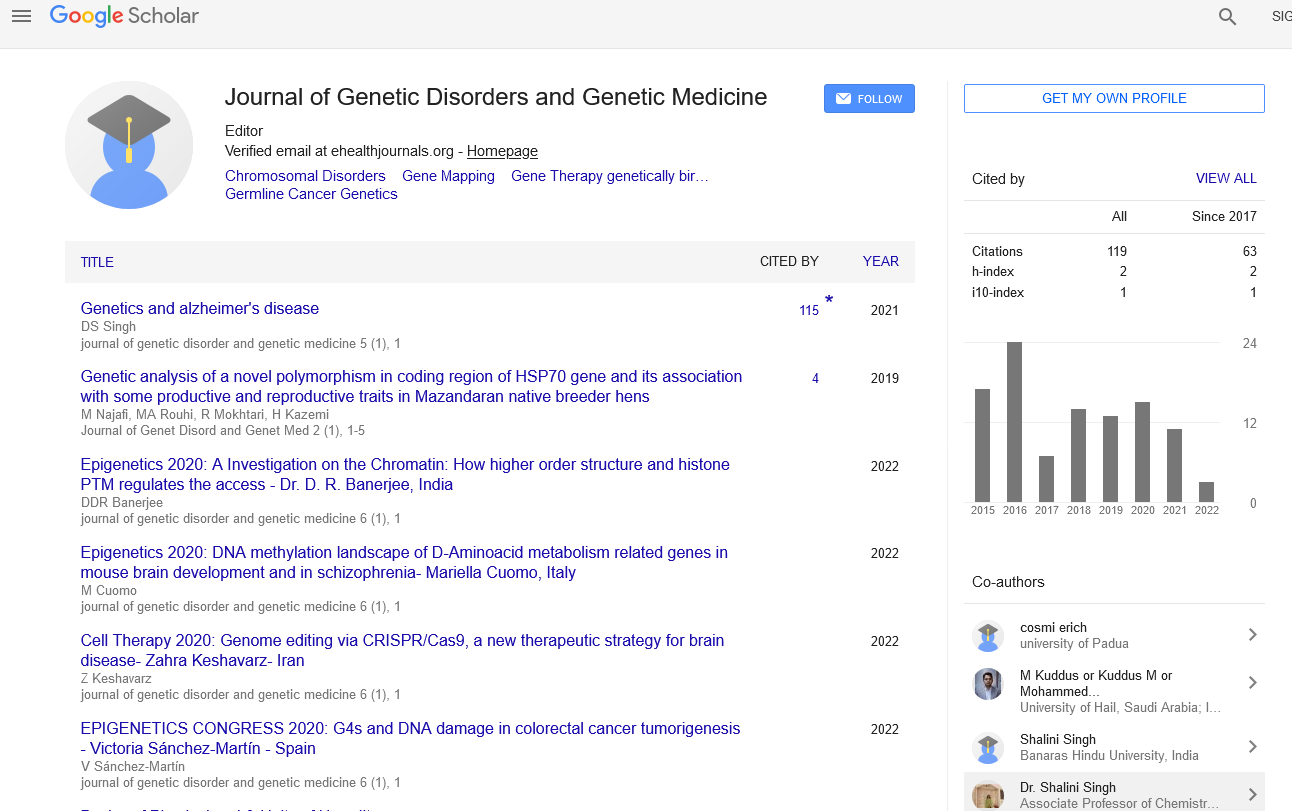Assemble DNA Damage Linked to Monogenic in an Infrequent Pediatric Disorder
Received: 02-Dec-2021 Accepted Date: Dec 10, 2022; Published: 22-Dec-2022
Citation: Kungur Samuel. Assemble DNA Damage Linked to Monogenic in an Infrequent Pediatric Disorder. J of Genet Disord and Genet Med 2021;5(4).
This open-access article is distributed under the terms of the Creative Commons Attribution Non-Commercial License (CC BY-NC) (http://creativecommons.org/licenses/by-nc/4.0/), which permits reuse, distribution and reproduction of the article, provided that the original work is properly cited and the reuse is restricted to noncommercial purposes. For commercial reuse, contact reprints@pulsus.com
Abstract
The unmended DNA damage is essentially responsible for the destructive neurodevelopmental irregularities associated with Aicardi-Goutieres syndrome (AGS), an infrequent childhood disorder. The findings from Children's Research Hospital reverse the belief that inflammation of Neuro was to be guilt. The paper appeared today in Neuron. Working in a recently developed mouse model of human AGS, researchers showed that the enzyme loss RNASEH2 led to uncertainty of genome in highly dividing cells of the developing brain.
Keywords
DNA damage; Pediatric Disorder; Neuro inflammation
Introduction
The unmended of DNA damage and result in the cells loss were the first cause of the seizures microcephaly, and other malformation of brain associated with AGS, "This clarify that defects in DNA restore cause serious neurodevelopmental harm in children affected by the disease," The work also provides awareness for studies to better understand the process of disease. There is no known cure for AGS and children with the severe form die within the first decade of life. The gene RNASEH2 is changed in more than half of AGS patients, making it the most mutation in common. This syndrome is also connected with Neuro inflammation from increased type 1 signaling of interferon. Type 1 is part of the inflammatory immune response by the interferon. This enzyme RNASEH2 had a role in repairing damaged DNA, which was understood by the researchers but AGS was considered a Neuro inflammatory disease. Mouse model is developed by the researchers of AGS to learn more about the process of disease. Investigators showed that RNASEH2 played an important role in maintaining integrity of DNA.
Mice that require RNASEH2 developed neurological damage that same human AGS. In difference, inhibiting type 1 interferon did not reduce the defects surely. "The enzyme takes off ribo nucleotides which are include and damage DNA in mostly dividing cells in the nervous system which is developed, " Data suggest that loss of RNASEH2 leaves DNA damage not repaired, letting it assemble and activate Neuro degeneration that is independent of Neuro inflammation." Researchers at Children's Institute for Genomic Medicine (RCIGM) have utilized a clinical natural language and machine-learning process refining (CNLP) to diagnose rare genetic diseases in record time. This method is fasting answers to for infants in intensive care and caring for physicians also opening the door to increased use of sequencing in genome as a first-line diagnostic test for babies with confusing conditions. It’s called artificial intelligence by some people, but it is intelligence of augmented which was called by us." By decrease the need for labor-intensive manual analysis of genomic data, the supervised automated pipeline provided important time-savings.
Conclusion
The RCIGM task is to bring about to speed and scale up genomic data and to reduce the time and cost of whole genome sequencing. That genome sequencing with automated phenotyping and interpretation in a median for hours may stimulant use in intensive care units which researchers are concluded, thereby enabling timely and precise medical care. The workflow of RCIGM is bring about to speed explanation of genomic data to reduce the cost and time of whole sequencing genome. The main goal is to make rWGS available and accessible to any child who needs it. One-third of those children have received a diagnosis of genetic with 25 percent of those benefiting from a quick change in clinical care based on their diagnosis.





